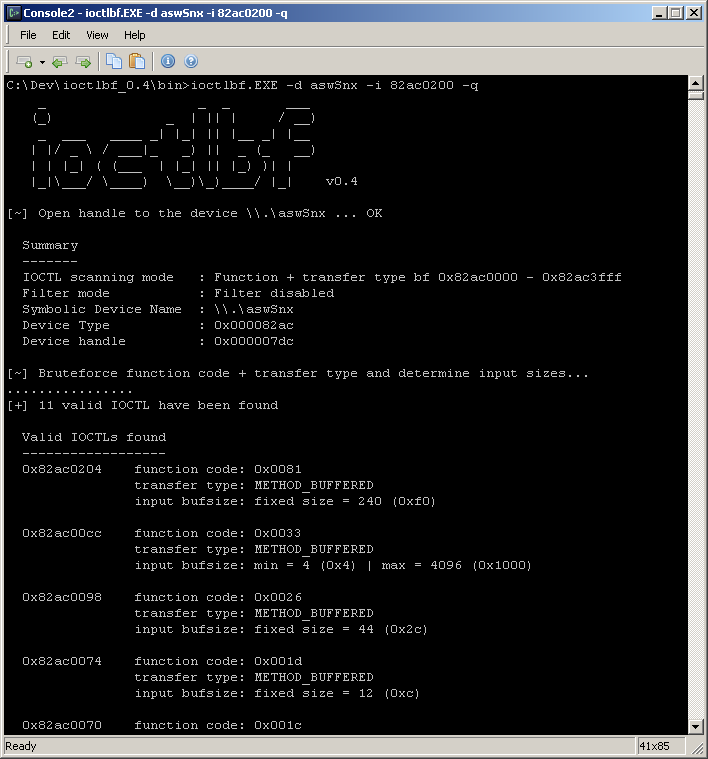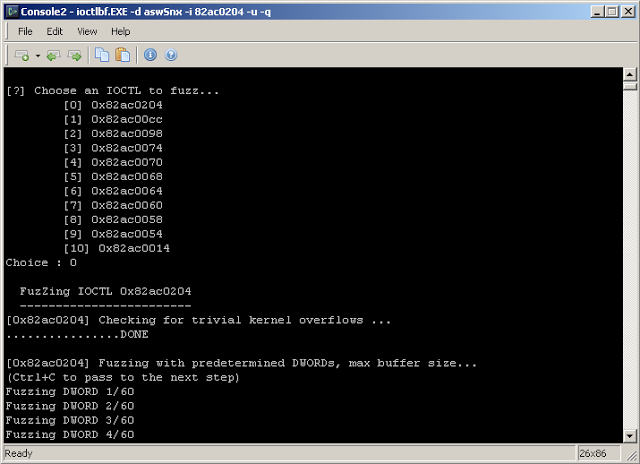koutto / Ioctlbf
Programming Languages
Projects that are alternatives of or similar to Ioctlbf
IOCTLbf
This is a project from back in tha dayz, in 2011-2012. Kinda dirty code, but worked for me to find several bugs in Windows Drivers.
Here is one of them: https://www.exploit-db.com/exploits/17902/
More info about this tool and kernel exploitation at: http://poppopret.blogspot.fr/
For french people, an article was also written in MISC Magazine #62: http://connect.ed-diamond.com/MISC/MISC-062/De-la-decouverte-d-une-vulnerabilite-dans-un-driver-Windows-a-l-elevation-de-privileges
Table of contents
Overview
IOCTLbf is just a small tool (Proof of Concept) that can be used to search vulnerabilities in Windows kernel drivers by performing two tasks:
- Scanning for valid IOCTLs codes supported by drivers,
- Generation-based IOCTL fuzzing
An advantage of this tool is that it does not rely on captured IOCTLs. Therefore, it is able to detect valid IOCTLs codes supported
by drivers and that are not often, or even never, used by applications from user land.
For example, it may be the case for:
- IOCTLs called in very specific conditions (not easy to discover and/or to reproduce).
- IOCTLs used for debugging purpose that are sometimes let in drivers.
Once scanning is done and valid IOCTLs have been found for a given driver, the user can choose one IOCTL in the list to begin the fuzzing process. Note that this tool only performs generation-based fuzzing. Compared to mutation-based fuzzing (which consists in taking valid IOCTL buffers and adding anomalies), the code coverage is of course less important.
Note: for mutation-based IOCTL fuzzing, check out the great tool IOCTL fuzzer (http://code.google.com/p/ioctlfuzzer/). Basically, it hooks NtDeviceIoControlFile in order to take control of all IOCTL requests throughout the system.
Reminder about IOCTLs
IOCTL codes
According to winioctl.h:
IOCTL's are defined by the following bit layout.
[Common |Device Type|Required Access|Custom|Function Code|Transfer Type]
31 30 16 15 14 13 12 2 1 0
Common - 1 bit. This is set for user-defined
device types.
Device Type - This is the type of device the IOCTL
belongs to. This can be user defined
(Common bit set). This must match the
device type of the device object.
Required Access - FILE_READ_DATA, FILE_WRITE_DATA, etc.
This is the required access for the
device.
Custom - 1 bit. This is set for user-defined
IOCTL's. This is used in the same
manner as "WM_USER".
Function Code - This is the function code that the
system or the user defined (custom
bit set)
Transfer Type - METHOD_IN_DIRECT, METHOD_OUT_DIRECT,
METHOD_NEITHER, METHOD_BUFFERED, This
the data transfer method to be used.
For a given device, only the fields "Function Code" and "Transfer Type"
change for the different supported IOCTL codes.
Buffer specifications
Buffer sizes:
Input Size = nt!_IO_STACK_LOCATION.Parameters.DeviceIoControl.InputBufferLength
Output Size = nt!_IO_STACK_LOCATION.Parameters.DeviceIoControl.OutputBufferLength
The way buffers are passed from userland to kernelland, and from kernelland to userland, depends on the method which is used. Here are the differences:
- METHOD_BUFFERED:
Input Buffer = nt!_IRP.AssociatedIrp.SystemBuffer
Output Buffer = nt!_IRP.AssociatedIrp.SystemBuffer
input & output buffers use the same location, so the buffer allocated by the I/O manager is the size of the larger value (output vs. input).
- METHOD_X_DIRECT:
Input Buffer = nt!_IRP.AssociatedIrp.SystemBuffer
Output Buffer = nt!_IRP.MdlAddress
the input buffer is passed in using "BUFFERED" implementation. The output buffer is passed in using a MDL (which permits Direct Memory Access). The difference between "IN" and "OUT" is that with "IN", you can use the output buffer to pass in data! The "OUT" is only used to return data.
- METHOD_NEITHER:
Input Buffer = nt!_IO_STACK_LOCATION.Parameters.DeviceIoControl.Type3InputBuffer
Output Buffer = nt!_IRP.UserBuffer
input & output buffers sizes may be different. The I/O manager does not provide any system buffers or MDLs. The IRP supplies the user-mode virtual addresses of the input and output buffer
Command line options
>ioctlbf.EXE
Usage
-----
ioctlbf.EXE -d <deviceName> (-i <code>|-r <code>-<code>) [-u] [-q] [-f] [-e]
Options
-------
-d Symbolic device name (without \\.\)
-i IOCTL code used as reference for scanning (see also -u)
-r IOCTL codes range (format: 00004000-00008000) to fuzz
-u Fuzz only the IOCTL specified with -i
-f Filter out IOCTLs with no buffer length restriction
-q Quiet mode (do not display hexdumps when fuzzing)
-e Display error codes during IOCTL codes scanning
-h Display this help
Examples
--------
Scanning by Function code + Transfer type bruteforce from given valid IOCTL:
> ioctlbf.EXE -d deviceName -i 00004000 -q
Scanning a given IOCTL codes range (filter enabled):
> ioctlbf.EXE -d deviceName -r 00004000-00004fff -f
Fuzzing only a given IOCTL (quiet mode):
> ioctlbf.EXE -d deviceName -i 00004000 -u -q
Usage
-
First of all, it is necessary to locate the target driver. A tool like DriverView (http://www.nirsoft.net/utils/driverview.html) can be used in order to easily spot non-Microsoft drivers (third-party drivers).
-
Then, it is necessary to check the device(s) associated with the target driver. A good tool to do this is DeviceTree for example (http://www.osronline.com/article.cfm?article=97)
-
Check the security attributes (DACL) of the device(s). It should be available for limited users in order to make it interesting froman attacker point of view. Indeed, vulnerabilities in drivers may lead to Local Privilege Escalation on the system, or just Denial of Service when it is not exploitable.
-
Retrieve the symbolic link used by applications to communicate with one device of the target driver. All symbolic links can be listed with the Sysinternal's tool WinObj in the "GLOBAL??" section (http://technet.microsoft.com/en-us/sysinternals/bb896657).
-
Finally, it is necessary to know at least one valid IOCTL code supported by the target driver. For example, it can be easily done by monitoring IRPs with a tool like OSR's IrpTracker Utility (http://www.osronline.com/article.cfm?article=199). Make sure to apply a filter on "DEVICE_CONTROL" only and to select only the target driver. Of course, it is also possible to retrieve valid IOCTL codes directly by reverse engineering the driver.
-
Once a valid IOCTL code is retrieved, ioctlbf can be used. One of the following IOCTL codes scanning modes can be chosen:
- Function code + Transfer type bruteforce
- IOCTL codes range
- Single IOCTL code The scanning process returns supported IOCTL codes and accepted buffer sizes for each one.
- The next step simply consists in chosing one IOCTL to fuzz. The fuzzing process actually follows the following steps:
- [if method != METHOD_BUFFERED] Invalid addresses of input/output buffers
- Check for trivial kernel overflows
- Fuzzing with predetermined DWORDs (invalid addresses, addresses pointing to long ascii/unicode strings, address pointing to a table of invalid addresses).
- Fuzzing with fully random data
Example
>ioctlbf.EXE -d aswSnx -i 82ac0200 -q
[~] Open handle to the device \\.\aswSnx ... OK
Summary
-------
IOCTL scanning mode : Function + transfer type bf 0x82ac0000 - 0x82ac3fff
Filter mode : Filter disabled
Symbolic Device Name : \\.\aswSnx
Device Type : 0x000082ac
Device handle : 0x000007dc
[~] Bruteforce function code + transfer type and determine input sizes...
................
[+] 11 valid IOCTL have been found
Valid IOCTLs found
------------------
0x82ac0204 function code: 0x0081
transfer type: METHOD_BUFFERED
input bufsize: fixed size = 240 (0xf0)
0x82ac00cc function code: 0x0033
transfer type: METHOD_BUFFERED
input bufsize: min = 4 (0x4) | max = 4096 (0x1000)
[...]
[?] Choose an IOCTL to fuzz...
[0] 0x82ac0204
[1] 0x82ac00cc
[2] 0x82ac0098
[3] 0x82ac0074
[4] 0x82ac0070
[5] 0x82ac0068
[6] 0x82ac0064
[7] 0x82ac0060
[8] 0x82ac0058
[9] 0x82ac0054
[10] 0x82ac0014
Choice : 0
FuzZing IOCTL 0x82ac0204
------------------------
[0x82ac0204] Checking for trivial kernel overflows ...
................DONE
[0x82ac0204] Fuzzing with predetermined DWORDs, max buffer size...
(Ctrl+C to pass to the next step)
[...]
Building from sources
-
Go to the directory .\src\
-
Edit the file "makefile.txt" (set correct API directories "API_DIRx") and the PATH in the file "build.bat"
-
Execute ".\build.bat release"


